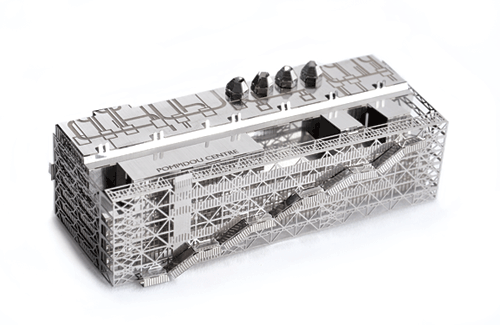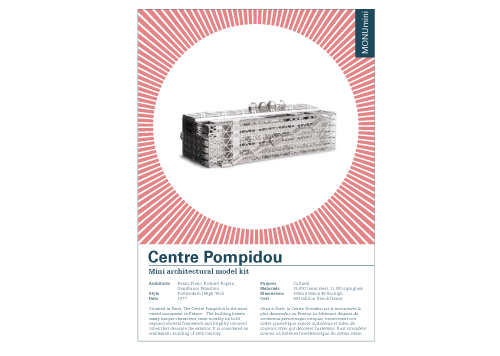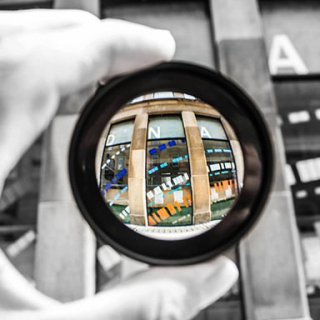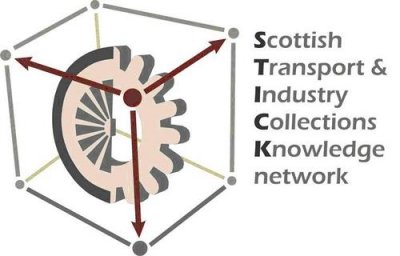Yasmin Ali
Urbanism // Design
Another Studio: MONUmini
December 7th, 2013
Another Studio is a London-based design company specialising in minature gifts inspired by architecture, the urban environment and gardens. They have a range of products perfect for architects' stocking fillers and Christmas gifts alike. Of their current products, the MONUmini is a range which reproduces iconic modernist architecture in fold-out minature steel kits. Examples include The Brandenburg Gate, Notre Dame, alongside London icons like Battersea Power Station (now Tate Modern), Tower Bridge and The Barbican, recently joined by the new release of the BT Tower edition. The European complement has also been joined by the new replica of the Centre Pompidou, Renzo Piano and Richard Rogers' High Tech masterpiece.
The dimensionality of the Pompidou Centre makes it an interesting building to model and have as a keepsake. The model once constructed is 3 cms high x 10cms wide. It comes as a kit including a single flat sheet of etched stainless steel, with instructions on how to fold and interlock the pieces to create the model. Another Studio's kits are designed to be easy and sturdy to post and construct, and include an A5 envelope and a brief history of the building.
---
The MONUmini kits are priced at £15.50 each, and retail online from Another Studio’s webshop.
There are several shop stockists of Another Studio products, including the RIBA Bookshop and The Red Door Gallery in Edinburgh.
---
another studio http://www.another-studio.com/
DNA Hub: Crowdfunding for Glasgow's Creative Community
October 30th, 2013
Glasgow’s creative scene has been on the rise for many years now, and is starting to be celebrated in the mainstream, with innovations like the MAKlab facility recently featured on Glasgow City Council’s ‘People Make Glasgow’ tourism campaign. A new community creative hub DNA, led by Darren Kavanagh, is revitalising an empty central retail unit in Glasgow’s Style Quarter that has been vacant since the late 90’s. Just off George Square, 12-16 Frederick Street is the home for pop-up shop and arts venue DNA. DNA will offer affordable display, retail and studio space for creative start-ups to exhibit and sell their work and run events. An artisan café is also planned as a welcoming frontage for the community.
DNA is engaging with the architectural community, and has hosted an exhibition by architectural research and design collective Lateral North. During the exhibition the collective held well-attended free design consultations for prospective clients and tutorials for Masters students. Next month, entries from the recent Glasgow Institute of Architects’ design competition will be displayed at an exhibition at the venue, with shortlisted entrants invited to present at the opening night on the 13th November.
Though yet completely renovated, in its first few months so far DNA has hosted over 200 events including art exhibitions, charity projects, fashion shows and pop-up events. The response from the creative community and the general public has been strong, with over 9000 visitors and a growing crowd-funding campaign currently online. The campaign aims to raise £10,000 to help finance the growth plans, and there are incentives including free shop and exhibition space, discounts, and marketing plans. A party is planned for the 30th November for all contributors. Kavanagh says “Contributing to this campaign will mean the world to not just us at DNA but the many people who use our spaces on a daily basis”.
--
Online campaign - http://www.indiegogo.com/projects/dna-glasgow-multi-use-community-hub
Connect with DNA on Facebook - https://www.facebook.com/DNAGLASGOW
// DNA Hub, 12-16 South Frederick Street, Glasgow G1 1HJ
// Glasgow Institute of Architects exhibition “Connecting The Seven Lochs”, opens Wednesday 13th November at DNA, and runs until 20th November.
Research Excellence Showcase @ GSA, 25.10.13 - Architecture, Urbanism and The Public Sphere
October 25th, 2013
This year The Glasgow School of Art hosted their first Research Excellence Showcase, which comprised a morning of two parallel sessions of talks from various departments; a networking and Q & A lunch, and organised transport in the afternoon for talks and demonstrations at the Digital Design Studio, currently sited at Pacific Quay.
The backdrop for this open day for interested collaborators is the upcoming Research Excellence Framework audit submission (REF), which supercedes previous RAE assessments, to rate the quality of research provision in higher education facilities every five years.
Under the theme of Architecture, Urbanism and The Public Sphere, there were three talks, from researchers each presenting for around 20 minutes. The session began with Dr. Johnny Rodger outlining some of his research under the title 'Argonautical Serendipity', used as a paradigm to analogise the indeterminate and often fortunate findings of his research. Rodger has an interest in how literary, artistic and creative writings are involved in social, political and spatial formations. He is co-author of the book 'Tartan Pimps' (2009), which first published the 1979 plans for The Scottish Parliament after a 30 year embargo.
Public participation in art was then discussed by Shauna McMullan of the Sculpture & Environmental Art Department, who introduced her recent community engagement project in association with Tramway, 'The Albert Drive Colour Chart'. Albert Drive is a 3 mile residential street in the Southside of Glasgow, named the most culturally diverse street in Scotland. 72 residents and community members, including Nicola Sturgeon MSP were invited to choose a colour of personal significance to add to a chart which was displayed in large scale in Tramway. They were also each given a limited edition print of the chart, numbered with a key denoting colours to individuals. This played with the idea of artwork as a gift with the potential to create connections between the participants.
Urban Design was introduced by Edinburgh-based architect Graeme Massie, winner of the RIBA Open International Design Project 2005 to redesign Bonn Square in Oxford (completed 2009). Massie's practice-based architectural research raised the quality of urban space by working along themes borrowed from Scandinavian influences, such as connecting people to place; the value of craft over industrialised modern architecture and the power of singularity in materials to lend character. The architects worked with an artist to generate a digital abstraction of magnified stone and translate this into a tiled surface combining split-faced and smooth surfaces of different shades to give different tonal qualities. The space was unified through its use of one material which was folded seamlessly over the site topography and adapted to be accessible via a shallow gradient ramp. Subtle patterns in the arrangement of stone demarcate different ownerships of the site. The project was awarded Commendations from the Architectural Review and The Oxford Preservation Trust Environmental Awards (2009).
Weblinks
Glasgow School of Art - here
GSA Research Repository (RADAR) - here
Graeme Massie Architects - here
Research Excellence Framework - here
STICK conference: 'FORM OR FUNCTION?' @ SHBT, 10-4pm, 19.10.2013
October 19th, 2013This year, STICK held their annual conference at the Scottish Heritage Building Trust in Riddle's Court, Edinburgh, along the them of Form vs Function in industrial design and engineering, specifically related to its impact on our perceptions of our past, present and future. It was introduced and chaired by Miriam McDonald and John Hume of RCAHMS, and included speakers from Glasgow School of Art, Museums in Glasgow and Edinburgh, and Directors from George Gilbert Associates.
Themes of talks along the dialectics of Form vs Function included academic discourse, museum collections, 3D printing, visual communication, longevity of design and ergonomics. Amongst the presentations those most relevant to architecture specifically included two in the afternoon which related to 3D printing, led by George Gilbert and Kelvin Donaldson, two founding directors of Edinburgh-based George Gilbert Associates and alumni of Edinburgh College of Art.
In 2006, George Gilbert Associates became the first architecture firm in Scotland to invest in in-house 3D printing technology and facilities, and began a two-year Research & Development program to learn the most efficient ways of working with the technology. The models produced allowed them to accurately portray to clients and planners editable prospective designs in physical form. The tactility and sense of scale allowed by the prints made the designs easy to read and comprehend. The 3D prints also fed back into the iterative design process and were used as a design tool to help generate and refine architectural and urban forms.
As well as in-house use, the firm takes specialist commissions from other architects and building design professionals, as well as signature architects like Will Alsop; in addition to applications by other industries, including gaming and museums. They have produced a 3D model for NMS of Craigellachie Bridge for the 250 year anniversary of Thomas Telford in 2007. This was produced using original engravings as the input for the plot files, and was especially significant as little cultural materials remain of Telford's estate as he did not marry nor have heirs. Rowan Brown of the National Mining Museum of Scotland spoke of the commission in the short talk which followed Gilbert Associates' presentation. The commission was doubly significant in both subject and medium as it represented the prowess of technology in its day as well as forming a record of the result contemporary engineering techniques used in 3D printing.
Other speakers included museum curators from National Museums Scotland and Glagow Museums, and academics and practitioners of design and engineering from Glasgow School of Art. The concluding talk was by Helen Britt from the GSA Textile department, who introduce the Stoddart-Templeton Design Studio + Library project, an archive spanning the company and its subsidiaries history from 1843-2005. This archive of physical material including drawings, samples and source materials has been acquired by GSA in partnership with the University of Glasgow and Glasgow Life. It forms the basis of an upcoming exhibition 'Interwoven Connections' at the Mackintosh Museum opening in early November this year.
All-in-all an interesting day with lively speakers dealing with the broad rhetoric of Form and Function from many original angles. The event was hosted at Scottish Historic Buildings Trust at Riddle's Court, Edinburgh, a beautiful A-listed building currently fundraising for upcoming conservation and development to form the Patrick Geddes Centre for Learning and Innovation.
With Thanks to STICK network.
Weblinks
STICK - here
STICK stands for the Scottish Transport & Industry Collections and Knowledge network, a group of professionals including museum curators, academics, engineers and designers who work together encourage wider engagement with transport and industrial collections across Scotland. It is free to join for interested individuals.
Gilbert Associates 3D website - here
Stoddart-Templeton Archive - here
Interwoven Connections: The Stoddart-Templeton Design Studio + Library 1843-2005. Mackintosh Museum, The Glasgow School of Art, 167 Renfrew Street, Glasgow G3 6RF, 9th November 2013 – 11th January 2014 (closed 24th December 2013 – 2nd January 2014)
SHBT - here
Online donations being taken for the building conservation campaign and programme at Riddle's Court.







